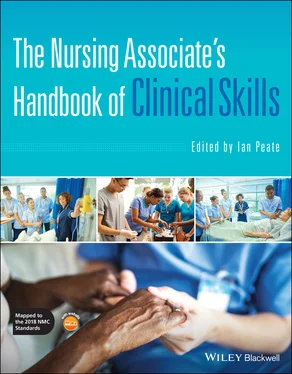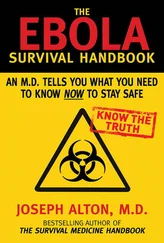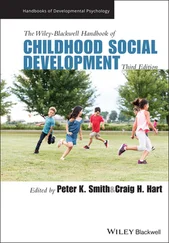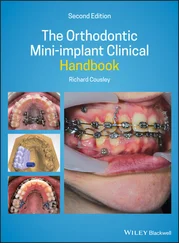The Nursing Associate's Handbook of Clinical Skills
Здесь есть возможность читать онлайн «The Nursing Associate's Handbook of Clinical Skills» — ознакомительный отрывок электронной книги совершенно бесплатно, а после прочтения отрывка купить полную версию. В некоторых случаях можно слушать аудио, скачать через торрент в формате fb2 и присутствует краткое содержание. Жанр: unrecognised, на английском языке. Описание произведения, (предисловие) а так же отзывы посетителей доступны на портале библиотеки ЛибКат.
- Название:The Nursing Associate's Handbook of Clinical Skills
- Автор:
- Жанр:
- Год:неизвестен
- ISBN:нет данных
- Рейтинг книги:4 / 5. Голосов: 1
-
Избранное:Добавить в избранное
- Отзывы:
-
Ваша оценка:
- 80
- 1
- 2
- 3
- 4
- 5
The Nursing Associate's Handbook of Clinical Skills: краткое содержание, описание и аннотация
Предлагаем к чтению аннотацию, описание, краткое содержание или предисловие (зависит от того, что написал сам автор книги «The Nursing Associate's Handbook of Clinical Skills»). Если вы не нашли необходимую информацию о книге — напишите в комментариях, мы постараемся отыскать её.
The Nursing Associate’s Handbook of Clinical Skills
The Nursing Associate’s Handbook of Clinical Skills
The Nursing Associate's Handbook of Clinical Skills — читать онлайн ознакомительный отрывок
Ниже представлен текст книги, разбитый по страницам. Система сохранения места последней прочитанной страницы, позволяет с удобством читать онлайн бесплатно книгу «The Nursing Associate's Handbook of Clinical Skills», без необходимости каждый раз заново искать на чём Вы остановились. Поставьте закладку, и сможете в любой момент перейти на страницу, на которой закончили чтение.
Интервал:
Закладка:
This chapter will focus on the underpinning knowledge of communication and will be followed by a series of chapters that will examine the specific communication skills required by the nursing associate. The Nursing and Midwifery Council (NMC) (2018) standards of proficiency for nursing associates require, at the point of registration, the nursing associate to communicate effectively using a range of skills and strategies with colleagues and people at all stages of life and with a range of mental, physical, cognitive and behavioural health challenges; this is closely related to platform 1, that is, being an accountable professional.
The World Health Organisation (WHO) defines communication as ‘the transfer of information, ideas or feelings’ (World Health Organization 2009, p.16). More recently, communication has been described as ‘the exchange of information between people by sending and receiving it through speaking, writing or by using any other medium’ (Sibiya 2018, p. 20). Effective communication means that information is conveyed clearly between people. To be an excellent nursing associate requires communication skills to engage effectively with patients using two‐way communication. Failure to recognise this two‐way communication could lead to negative conclusions, negative attitudes and dissatisfaction. The nursing associate must, therefore, continuously try to improve their communication skills to ensure high quality patient‐centred care.
Models of communication help us to consider the processes involved when communicating in several arenas with a variety of people. They provide a visual representation of the different aspects of a communication encounter, simplifying the numerous steps the nursing associate needs to consider. Having this underpinning knowledge can help the nursing associate think about their current communication encounters, plan for future communication encounters and reflect and learn from the previous ones. The three main models that will be discussed in this chapter are the transmission/linear, interaction and transaction models of communication.
Transmission Model of Communication
In 1949, Shannon and Weaver first described the transmission, or linear, model of communication which consists of a sender creating a message which they send to the receiver without any feedback (see Figure 1.1.). This model describes communication as one way, from sender to receiver, which suggested that the sender and receiver had little to do with the interpretation of the message. The model does recognise physical noise as a communication barrier.
The main issue with one‐way communication is that it does not include feedback which enables the sender and receiver to ensure that the meaning within the message has been understood. Relying on one‐way communication can have an impact on patient outcomes. An example of this might be where a nursing associate advises the patient how to apply a cream but does not check whether the patient has understood the information. This could lead to the cream being applied incorrectly and delaying or even worsening the patient’s condition. Communicating in this way has been described as something you do ‘to’ someone.
Communication models have evolved since the linear model was first described over 70 years ago, but the model was useful in that it established some terms which have subsequently been adopted and developed further (see Table 1.1).
The nursing associate will already have thought about the different aspects of communication. They may have realised that they communicate with colleagues differently when they are tired (sender) and that they adapt their tone of voice when talking to a young child (receiver). They may have considered the message being conveyed by avoiding medical terminology when telling patients about their treatment. They may have considered providing written and verbal instructions to convey the information (code). They will have considered the channel of communicating, for example, if a patient cannot hear, they may have written down the message or have taken the patient into a side room away from the noise of the ward environment.

Figure 1.1 Transmission model of communication.
Source: Adapted from Shannon & Weaver (1949).
Table 1.1 Common communication terms.
Source : Adapted from Kiernan (2015).
| TERM | MEANING |
|---|---|
| Sender/receiver | The sender is the source of the communication. Anyone who is audience to the message is referred to as the receiver. |
| Message | The information being conveyed. |
| Code | Sometimes referred to as encoding and decoding . Encoding can be defined as transforming an abstract idea into a communicable message, using words, symbols, pictures, symbols and sounds. Decoding is when the receiver interprets the message and comes to an understanding about what the source is communicating. |
| Channel | The way the code is conveyed, for example, it may be easier to present complex information in a graph rather than written word alone. |
| Noise | Communication barrier. |
The Interactive Model of Communication
The interactive or interaction model of communication relies on an exchange of communication from the sender to the receiver and back again creating two‐way communication within physical and psychological contexts (Schramm 1997). The main difference between one‐ and two‐way communication is that two‐way communication provides feedback which enables the sender and receiver to ensure that the meaning within the information has been understood. It, therefore, closes the communication loop and is one way of minimising misunderstandings in the receiver’s interpretation of the original meaning of the message.
This model is more interaction focused and concerned with the communication process itself. This model acknowledges that with so many messages being sent at one time, many of them may not even be received and some messages may be sent unintentionally.
The interactive model also takes into consideration the communicator’s fields of experience and physical barriers. It also introduces semantic and psychological barriers. Physical barriers are vitally important as nursing associates must be able to care for people in a broad range of settings, including at home, close to home and in hospital, within a context of challenging environments. Nursing associates work with patients and their carers and families during times of heightened stress, anxiety and fear, and these emotions can affect our communication. Feedback and context help make this model of communication more useful than the transmission model for exploring individual communication encounters. The interactive model is depicted in Figure 1.2.
Orange Flag
 Psychological barriers include the mental and emotional factors in a communication encounter
Psychological barriers include the mental and emotional factors in a communication encounter
One of the main issues with the interactive model of communication is that it suggests communication is predictable and orderly, that is, A asks B a question and B responds. The reality of communication, especially in healthcare, is that it is much more disorganised with interruptions and people talking at the same time.
Читать дальшеИнтервал:
Закладка:
Похожие книги на «The Nursing Associate's Handbook of Clinical Skills»
Представляем Вашему вниманию похожие книги на «The Nursing Associate's Handbook of Clinical Skills» списком для выбора. Мы отобрали схожую по названию и смыслу литературу в надежде предоставить читателям больше вариантов отыскать новые, интересные, ещё непрочитанные произведения.
Обсуждение, отзывы о книге «The Nursing Associate's Handbook of Clinical Skills» и просто собственные мнения читателей. Оставьте ваши комментарии, напишите, что Вы думаете о произведении, его смысле или главных героях. Укажите что конкретно понравилось, а что нет, и почему Вы так считаете.












